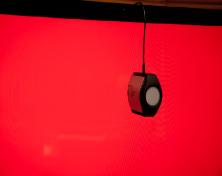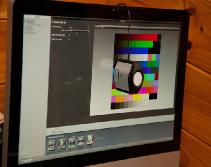|
|
|
How an ICC monitor profile is madeMonitor profiling requires a colorimeterTo make a profile for a monitor you use a device called a colorimeter. A colorimeter is a carefully calibrated tool that can accurately measure the wavelengths of emissive light. We place the colorimeter on the front of the monitor and connect it, usually via a USB cable, to the computer. |
||||||||
Colour Management |
||||||||
|
Monitors, printers, and colour |
||||||||
The Colour Match Challenge |
||||||||
|
|
||||||||
 |
||||||||
 |
||||||||
Left: The start of a monitor profiling. Right: Measurement in progress. Mouse over the picture to see the process. |
||||||||
How the Challenge is met |
||||||||
We then run a little software program that generates, in the 'language' of the computer's device-independent colour space, the number triples for a large, carefully chosen, sample of colours of known wavelength, and sends those triples to the monitor. The colorimeter measures the actual colours as they appear on the screen, and compares those with the true colours that were sent by the software. The profile-building software then works out what changes need to be made to each number triple if the measured colour on the monitor is to be the same as the colour sent from the device-independent colour space. The required changes are built into a conversion table, like a dictionary, that will translate all colour numbers so that the colours actually made on the screen are the same as the true colours sent from the device-independent colour space. The profiling program saves the measured ICC monitor profile (the dictionary) in a special place in the computer's file system and instructs the operating system to use this measured profile in place of the default one whenever an image is displayed on the screen. Calibration A monitor needs to be calibrated before it can be profiled. Calibration is not the same as profiling although some profiling software facilitates pre-profiling calibration. Calibration is the process of putting the hardware into a known stable state of operation. Many monitors have controls – buttons, or an on-screen display – that allow the user to adjust the calibration. Features that need to be controlled before profiling are the brightness of the display, the colour temperature of the 'white' that will be used and the contrast control, or 'gamma' of the display. If your monitor has these controls - you should try to adjust the brightness of the screen so that a blank 'white' document on the screen appears about the same brightness as a blank piece of photo paper when illuminated by the light under which you would normally evaluate a print. Some hardware suppliers suggest specific numbers to adjust the brightness of CRT screens versus LCD screens. Generally the numbers advised are too bright and make screen print matching impossible. The correct brightness is the brightness that produces the best visual match between screen and print. If the controls allow it, set the display 'gamma' to 2.2. Otherwise set the contrast as high as possible. Finally, if your monitor has RGB controls or another way of setting the colour temperature of the white point, set it to 65˚K (D65). Some LCD monitors work best with the colour temperature set to use the display's 'native' white point. (Theoretically white light has equal amounts of R,G, and B. In practice daylight may be 'warmer' because it has a slightly greater amount of red/yellow or cooler because it has a slightly greater amount of blue. D65 approximates the slightly cooler, bluer, midday daylight.) Consider this.... If you are a photographer who is serious about digital imaging and creating the finest possible prints, then you should re-calibrate and re-profile your display relatively regularly because display characterisitics are known to drift. Experts recommend reprofiling at least 4 times a year. If your monitor has the controls you need no further equipment to calibrate it, but profiling a monitor (computer display) does require the use of a colorimeter and profiling software. Hiring a colorimeter and software (where licensing allows it) or hiring a service like Borderfields Photographic to profile your monitor, could become expensive over time. Given the importance of a continuously well-profiled monitor in managing accurate colour, many photographers will want to own their own display colorimeter. Good colorimeters such as the X-Rite i1 Display Pro, Colormunki Display, or Spyder 3 cost between $NZ200 and $NZ400 – very much less than the cost of a good digital camera or monitor. Spectrophotometers like the i1 Pro and Colormunki Photo, which are used to make printer profiles are much more expensive. A spectrophotometer has its own light source that is used when making printer profiles but can be turned off when measuring the light emitted by a display. The measuring part of the instrument is different from that in a colorimeter. Spectros are often less effective than a cheaper, dedicated, colorimeter, for creating monitor profiles that provide good shadow tonality. Borderfields Photographic does NOT sell profiling hardware or software for either computer displays or printers. I am happy to provide advice based on my experience. |
||||||||
|
Translating colours: ICC Profile |
||||||||
